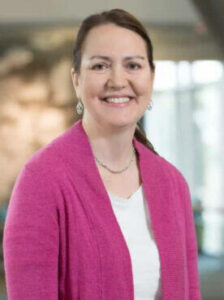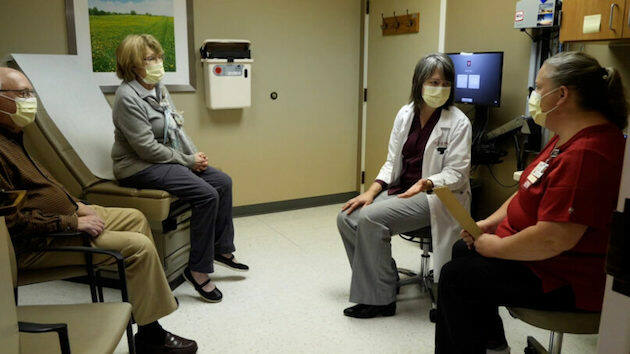The positive impact of Chaplains on ICU families

It’s hard to forget your first time in the ICU.
Strangers obscured by masks and gowns, beds surrounded by wires, constant beeping — it can feel like you’ve stumbled into a warped, disorienting alternate universe.
It’s true for patients — and it’s true for their loved ones.
For decades, hospital chaplains have offered hope and solace to patients and family alike as they navigate the trauma of being in the intensive care unit. But the impact of those efforts is often intangible, hard to measure and generally anecdotal.
But thanks to a new study of ICU patients’ family members and loved ones, data now confirms what many chaplains already know: Proactive, enhanced spiritual care leads to better spiritual and psychological outcomes.
“We wanted to improve the well-being of ICU family members because there’s so much distress that they face, and we were one of the very few studies that have been able to successfully do that,” said Dr. Alexia Torke, who led the study conducted by the Regenstrief Institute and Indiana University School of Medicine.
The randomized, single-blind trial took place across an Indiana medical center’s five ICUs from August 2018 until November 2021. The 128 participants who completed the trial were surrogate decision-makers whose loved ones were ICU patients unable to make medical decisions.

The study found that surrogates who received intensive spiritual care had more spiritual well-being and satisfaction with spiritual care and were “less likely to have anxiety and spiritual distress compared to those in control group,” according to Torke, a research scientist at Indiana University Center for Aging Research. Surrogates in the intervention group were “three times more likely to have a clinically important reduction in anxiety,” according to the study.
When Paul Galchutt, a research chaplain at the University of Minnesota Medical Center, heard the trial’s results, he told Religion News Service, “I clicked my heels a few times.” Galchutt described this kind of data “like a V8 engine for the kind of work we do,” because it provides hard numbers to tell the story of what chaplains do and why it matters.
The trial studied two groups: a control group receiving typical care from the medical center’s chaplains, and an intervention group that would receive intensive spiritual care from one of five outside chaplains. In the first group, surrogates saw a chaplain an average of two times during their relative’s stay, whereas the second group had an average of four visits per stay.
READ: How the role of chaplains is changing
Chaplains in the enhanced spiritual care group also made proactive contact to schedule visits and implemented a spiritual care assessment and intervention framework to evaluate surrogates in several areas, including relationships, self-worth and meaning. During their first visit, chaplains asked at least one pre-written question from each of the categories, then adapted the conversation to best suit the surrogate’s needs.
“It really led me to ask questions that I might have sort of skipped over other times or might have put on sort of the back burner for another conversation or a follow-up visit,” said Shelley Varner Perez, a research chaplain at Indiana University Health and one of the chaplains in the study. “I think that really helped me learn about things that were important I might have missed in my usual practice.”
One in 4 Americans have been served by a chaplain, according to a March 2022 Gallup poll for Brandeis University’s Chaplaincy Innovation Lab, with half of those people encountering chaplains in a healthcare setting. But despite their high exposure to chaplains, many Americans’ understanding of chaplaincy is fuzzy at best.
“People have this stereotype that they come for Christian prayer and at end of life,” said Torke. “They do those things, absolutely, but the chaplains are trained to care for people of any religion and people of no religion. And that’s because the chaplains define spirituality broadly, to include those questions of meaning, purpose, transcendence and relationships that are universal.”
Kate Kozinski, a hospice chaplain in Maine who was involved in the pilot and first year of the study’s trial, says she regularly sees the impact of spiritual care in health care settings as patients and their loved ones contemplate difficult decisions — and mortality.
“They’re kind of teasing apart, frequently, their lived experience of God or of the Divine with what sometimes the religious institutions they belong to have told them about that. And sometimes there’s a disconnect between their lived experience and what they’ve been taught to believe about God and how God functions,” Kozinski said.
“I have an opportunity as a chaplain to sit with people to kind of bridge that gap.”
She added that while anecdotal evidence about the impact of chaplaincy is enough to motivate her work, it’s been rewarding to be part of a project that demonstrates its efficacy.

Wendy Cadge, a sociology professor at Brandeis University in Waltham, Massachusetts, and founder of the Chaplaincy Innovation Lab, said she hopes the study helps health care executives see the value of investing in and understanding chaplaincy. “Through the lab and other avenues we have spent a lot of time trying to make sure that chaplains are trained well to do the work,” said Cadge. “But if the decision-makers in health care either are not aware of the work or have a different understanding than chaplains themselves, or just don’t have the dollars, then people can be perfectly trained, but they’re still not going to be able to do their best work.”
Varner Perez said that as a chaplain in the study, she saw the value of proactively contacting families even if they’re not able to physically visit their loved one due to their jobs, child care responsibilities, transportation costs or economic barriers. She added that when COVID-19 broke out, the chaplains had to pivot to offering care by phone. To her surprise, that form of care was both accessible and effective.
Participants in the study skewed Christian: About 70% were Protestant, 13% Catholic and 12% had no religion, along with a smattering of other religions. About 78% of the surrogates were white and 21% were Black.
For Torke, the distress that family members face in the ICU is a matter of public health. Too often, they experience anxiety, depression, spiritual distress and post-traumatic distress — but, this study shows, “there is something we can do about it.”
“Amid tragedy and trauma, everybody wants to be able to know somebody cared about them and their loved one and can do so in a skillful way. We do that,” Galchutt said about chaplains. “And now I’m glad there’s some data that helps us say that as well.”
–by Kathryn Post | ReligionNews | Used wtih permission.






